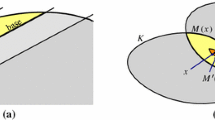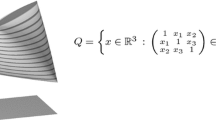Abstract
This paper studies the complexity of computing (or approximating, or bounding) the various inner and outer radii of ann-dimensional convex polytope in the space ∝n equipped with an ℓ p norm or a polytopal norm. The polytopeP is assumed to be presented as the convex hull of finitely many points with rational coordinates (V-presented) or as the intersection of finitely many closed halfspaces defined by linear inequalities with rational coefficients (ℋ-presented). The innerj-radius ofP is the radius of a largestj-ball contained inP; it isP's inradius whenj = n and half ofP's diameter whenj = 1. The outerj-radius measures how wellP can be approximated, in a minimax sense, by an (n — j)-flat; it isP's circumradius whenj = n and half ofP's width whenj = 1. The binary (Turing machine) model of computation is employed. The primary concern is not with finding optimal algorithms, but with establishing polynomial-time computability or NP-hardness. Special attention is paid to the case in whichP is centrally symmetric. When the dimensionn is permitted to vary, the situation is roughly as follows: (a) for general ℋ-presented polytopes in ℓ p spaces with 1<p<∞, all outer radius computations are NP-hard; (b) in the remaining cases (including symmetric ℋ-presented polytopes), some radius computations can be accomplished in polynomial time and others are NP-hard. These results are obtained by using a variety of tools from the geometry of convex bodies, from linear and nonlinear programming, and from the theory of computational complexity. Applications of the results to various problems in mathematical programming, computer science and other fields are included.
Similar content being viewed by others
References
A.V. Aho, J.E. Hopcroft and J.D. Ullman,The Design and Analysis of Computer Algorithms (Addison-Wesley, Reading, MA, 1974).
M. Akgül,Topics in Relaxation and Ellipsoidal Methods (Pitman, Boston, MA, 1984).
T.S. Arthanari and Y. Dodge,Mathematical Programming in Statistics (Wiley, New York, 1981).
M.D. Ašić and V.V. Kovačević-Vujčić, “NP-hard problems and test problems for global concave minimization methods,”Yugoslavian Journal of Operations Research 1 (1991) 45–50.
H.L. Bodlaender, P. Gritzmann, V. Klee and J. van Leeuwen, “The computational complexity of norm-maximization,”Combinatorica 10 (1990) 203–225.
A. Brøndsted,An Introduction to Convex Polytopes (Springer, New York, 1983).
S.A. Cook, “The complexity of theorem proving procedures,” in:Proceedings of the 3rd ACM Symposium on the Theory of Computation (1971) pp. 151–158.
M.E. Dyer, “The complexity of vertex enumeration methods,”Mathematics of Operations Research 8 (1983) 381–402.
H. Edelsbrunner,Algorithms in Computational Geometry (Springer, New York, 1987).
B.C. Eaves and R.M. Freund, “Optimal scaling of balls and polyhedra,”Mathematical Programming 23 (1982) 138–147.
D.J. Elzinga and D.W. Hearn, The minimum covering sphere problem,”Management Science 19 (1972) 96–104.
R.M. Freund and J.B. Orlin, “On the complexity of four polyhedral set containment problems,”Mathematical Programming 33 (1985) 139–145.
M.R. Garey and D.S. Johnson,Computers and Intractability. A Guide to the Theory of NP-Completeness (Freeman, San Francisco, CA, 1979).
P. Gritzmann, L. Habsieger and V. Klee, “Good and bad radii of convex polygons,”SIAM Journal of Computing 20 (1991) 395–403.
P. Gritzmann and V. Klee, “On the 0–1 maximization of positive definite quadratic forms,” in:Operations Research Proceedings (Springer, Berlin, 1989) pp. 222–227.
P. Gritzmann and V. Klee, “Inner and outerj-radii of convex bodies in finite dimensional normed spaces,”Discrete Computational Geometry 7 (1992) 255–280.
P. Gritzmann and V. Klee, “On the error of polynomial computations of width and diameter,” in preparation.
C. Groenewoud, L. Eusanio and C.L. Lawson, “The smallest covering cone or sphere,”SIAM Review 7 (1965) 415–417.
M. Grötschel, L. Lovász and A. Schrijver,Geometric Algorithms and Combinatorial Optimization (Springer, Berlin, 1988).
B. Grünbaum,Convex Polytopes (Wiley, London, 1967).
M.E. Houle and G.T. Toussaint, “Computing the width of a set,” in:Proceedings of the Symposium on Computational Geometry (1985) pp. 1–7.
N. Karmarkar, “A new polynomial-time algorithm for linear programming,”Combinatorica 4 (1984) 373–397.
R.M. Karp, “Reducibility among combinatorial problems,” in: R.E. Miller and J.W. Thatcher, ed.,Complexity of Computer Computations (Plenum Press, New York, 1972) pp. 85–103.
L.G. Khachian, “Polynomial algorithms in linear programming,”USSR Computational Mathematics and Mathematical Physics 20 (1980) 53–72.
M.K. Kozlov, S.P. Tarasov and L.G. Hacijan, “Polynomial solvability of convex quadratic programming,”Soviet Mathematics Doklady 20 (1979) 1108–1111.
Y. Kurozumi and W.A. Davis, “Polygonal approximation by the minimax method,”Computer Graphics and Image Processing 19 (1982) 248–264.
L. Lovász, “An algorithmic theory of numbers, graphs and convexity,”AMS-SIAM Regional Conference Series (Philadelphia, PA, 1986).
O.L. Mangasarian, R. Setiono and W.H. Wolberg, “Pattern recognition via linear programming: theory and application to medical diagnosis,” in:Proceedings of the SIAM Workshop on Large-Scale Numerical Optimization, 1989 (Cornell University, Ithaca, NY, 1990).
O.L. Mangasarian and W.H. Wolberg, “Cancer diagnosis via linear programming,”SIAM News 23(5) (1990) 17–18.
P. McMullen, “The maximum number of faces of a convex polytope,”Mathematika 17 (1970) 179–184.
N. Megiddo, “Linear-time algorithms for linear programming inR 3 and related problems,”SIAM Journal on Computing 12 (1983) 759–776.
N. Megiddo, “On the complexity of some geometric problems in unbounded dimension,”Journal of Symbolic Computing 10 (1990) 327–334.
C.H. Papadimitriou and K. Steiglitz,Combinatorial Optimization: Algorithms and Complexity, (Prentice-Hall, Englewood Cliffs, NJ, 1982).
T. Pavlidis,Structural Pattern Recognition (Springer, New York, 1977).
P. Pilibossian and G. der-Megreditchian, “Recherche d'une fonction de regression par le critère du minimax,”Publications de l'Institute de Statistique de l' Université de Paris 28 (1983) 59–92.
A. Pinkus,n-Widths in Approximation Theory (Springer, Berlin, 1985).
J. Piper and E. Granum, “On fully automatic feature measurement for banded chromosome classification,”Cytometry 10 (1989) 242–255.
F.P. Preparata and M.I. Shamos,Computational Geometry (Springer, New York, 1985).
T.J. Schaefer, “The complexity of satisfiability problems,” in:Proceedings of the 10th Annual ACM Symposium on Theory of Computation (1978) pp. 216–226.
A. Schrijver,Linear and Integer Programming (Wiley, New York, 1987).
R. Seidel, “Output-size sensitive algorithms for constructive problems in computational geometry,” Ph.D. Thesis, Department of Computer Science, Cornell University (Ithaca, NY, 1987).
N.Z. Shor,Minimization Methods for Non-Differentiable Functions (Springer, New York, 1985).
I. Singer,Best Approximations in Normed Linear Spaces by Elements of Linear Subspaces (Springer, New York, 1970).
G. Strang, “The width of a chair,”American Mathematical Monthly 89 (1982) 529–534.
G. Swart, “Finding the convex hull facet by facet,”Journal of Algorithms 6 (1985) 17–48.
V.M. Tihomirov, “Diameters of sets in functional spaces and the theory of best approximation,”Russian Mathematical Surveys 15 (1960) 75–111. [Translated fromUspehi Mathematik Nauk 15 (1960) 81–120.]
K. Zindler, “Über konvexe Gebilde I,”Monatshefte für Mathematik und Physik 30 (1919) 87–102.
Author information
Authors and Affiliations
Additional information
Many of the results of this paper and also of [5, 14–17] were obtained in 1987 while both authors were visiting the Institute for Mathematics and its Applications, Minneapolis, MN 55455. The papers [5, 14–16] have appeared as IMA preprints.
Research supported in part by the Alexander-von-Humboldt foundation and by the Deutsche Forschungsgemeinschaft.
Research supported in part by the National Science Foundation.
Rights and permissions
About this article
Cite this article
Gritzmann, P., Klee, V. Computational complexity of inner and outerj-radii of polytopes in finite-dimensional normed spaces. Mathematical Programming 59, 163–213 (1993). https://doi.org/10.1007/BF01581243
Received:
Revised:
Issue Date:
DOI: https://doi.org/10.1007/BF01581243




